
Mecklenburg is a historical region in northern Germany comprising the western and larger part of the federal-state Mecklenburg-Western Pomerania. The largest cities of the region are Rostock, Schwerin, Neubrandenburg, Wismar and Güstrow.

Mecklenburg-Vorpommern, also known by its anglicized name Mecklenburg–Western Pomerania, is a state in the north-east of Germany. Of the country's sixteen states, Mecklenburg-Vorpommern ranks 14th in population; it covers an area of 23,179 km2 (8,949 sq mi), making it the sixth largest German state in area; and it is 16th in population density. Schwerin is the state capital and Rostock is the largest city. Other major cities include Neubrandenburg, Stralsund, Greifswald, Wismar, and Güstrow. It was named after the 2 regions of Mecklenburg and Vorpommern.
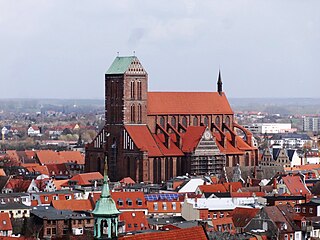
Wismar, officially the Hanseatic City of Wismar is, with around 43,000 inhabitants, the sixth-largest city of the northeastern German state of Mecklenburg-Vorpommern, and the fourth-largest city of Mecklenburg after Rostock, Schwerin and Neubrandenburg. The city was the third-largest port city in former East Germany after Rostock and Stralsund.
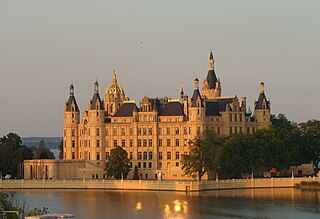
Schwerin is the capital and second-largest city of the northeastern German state of Mecklenburg-Vorpommern as well as of the region of Mecklenburg, after Rostock. It has around 96,000 inhabitants, and is thus the least populous of all German state capitals.

Rostock, officially the Hanseatic and University City of Rostock, is the largest city in the German state of Mecklenburg-Vorpommern and lies in the Mecklenburgian part of the state, close to the border with Pomerania. With around 208,000 inhabitants, it is the third-largest city on the German Baltic coast after Kiel and Lübeck, the eighth-largest city in the area of former East Germany, as well as the 39th-largest city of Germany. Rostock was the largest coastal and most important port city in East Germany.

Stralsund, officially the Hanseatic City of Stralsund, is the fifth-largest city in the northeastern German federal state of Mecklenburg-Western Pomerania after Rostock, Schwerin, Neubrandenburg and Greifswald, and the second-largest city in the Pomeranian part of the state. It is located at the southern coast of the Strelasund, a sound of the Baltic Sea separating the island of Rügen from the Pomeranian mainland.

Neustrelitz is a town in the Mecklenburgische Seenplatte district in the state of Mecklenburg-Vorpommern, Germany. It is situated on the shore of the Zierker See in the Mecklenburg Lake District. From 1738 until 1918 it was the capital of the Duchy of Mecklenburg-Strelitz. From 1994 until 2011 it was the capital of the district of Mecklenburg-Strelitz.
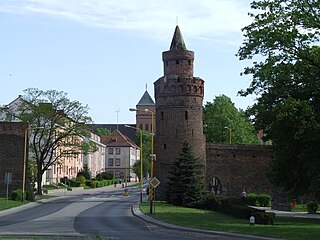
Pyrzyce is a town in Pomerania, north-western Poland. As of 2007, it had 13,331 inhabitants.

Gryfice is a historic town in Pomerania, north-western Poland, with 16,600 inhabitants (2017). It is the capital of Gryfice County in West Pomeranian Voivodeship, previously in Szczecin Voivodeship (1975–1998). The town is situated approximately 22 kilometres from the Baltic Sea coast and seaside resorts.
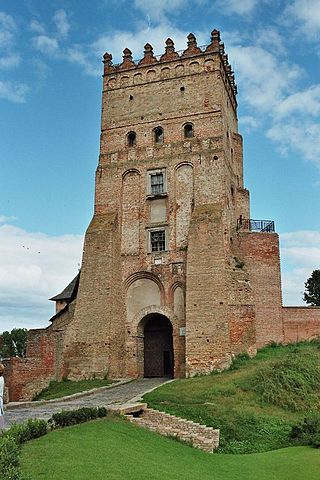
Volhynia, is a historic region in Central and Eastern Europe, between south-eastern Poland, south-western Belarus, and western Ukraine. The borders of the region are not clearly defined, but the territory that still carries the name is Volyn Oblast, in western Ukraine. Volhynia has changed hands numerous times throughout history and been divided among competing powers. For centuries it was part of the Polish-Lithuanian Commonwealth. After the Russian annexation, all of Volhynia was part of the Pale of Settlement designated by Imperial Russia on its south-western-most border.

The Black Sea Germans are ethnic Germans who left their homelands, and settled in territories off the north coast of the Black Sea, mostly in the territories of the southern Russian Empire.

Bergen auf Rügen is the capital of the former district of Rügen in the middle of the island of Rügen in Mecklenburg-Western Pomerania, Germany. Since 1 January 2005, Bergen has moreover been the administrative seat of the Amt of Bergen auf Rügen, which with a population of over 23,000 is Mecklenburg-Vorpommern's most populous Amt.

Garz is a town in the county of Vorpommern-Rügen in the German state of Mecklenburg-Vorpommern. The town is administered by the Amt of Bergen auf Rügen, in the town of the same name.
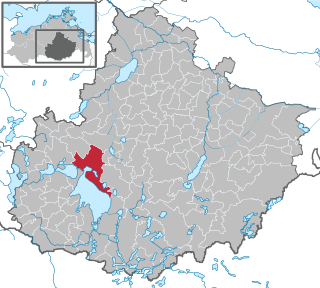
Waren (Müritz) is a town and climatic spa in the state of Mecklenburg-Vorpommern, Germany. It was the capital of the former district of Müritz until the district reform of 2011. It is situated at the northern end of Lake Müritz, approximately 40 kilometres west of Neubrandenburg. Waren is home to the offices of the sub-district (Amt) of Seenlandschaft Waren, although the town itself is independent of any Amt. Its borough is the second largest in Mecklenburg-Hither Pomerania by area.

Groitzsch is a town in the Leipzig district, in Saxony, Germany.

Tribsees is a municipality in the Vorpommern-Rügen district, in Mecklenburg-Vorpommern, Germany. It is situated 33 km southwest of Stralsund, and 40 km east of Rostock.

Bresegard bei Picher is a small municipality in the German state of Mecklenburg-Vorpommern. Often it is simply referred to simply as Bresegard. There is another municipality within Mecklenburg also called Bresegard and to differentiate the two 'bei Picher' is added, signifying a close proximity to the town of Picher. The other Bresegard is near the town of Eldena and is called Bresegard bei Eldena. Bresegard bei Picher, part of the Amt of Hagenow-Land and the district (Landkreis) of Ludwigslust, is near the main highway between Berlin and Hamburg.

Historical Western Pomerania, also called Cispomerania,Fore Pomerania, Front Pomerania or Hither Pomerania, is the western extremity of the historic region of Pomerania forming the southern coast of the Baltic Sea, Western Pomerania's boundaries have changed through the centuries as it belonged to various countries such as Poland, the Duchy of Pomerania, Sweden, Denmark, as well as Prussia which incorporated it as the Province of Pomerania.

Ostsiedlung is the term for the Early Medieval and High Medieval migration-period when ethnic Germans moved into the territories in the eastern part of Francia, East Francia, and the Holy Roman Empire and beyond; and the consequences for settlement development and social structures in the areas of immigration. Generally sparsely and only relatively recently populated by Slavic, Baltic and Finnic peoples, the area of colonization, also known as Germania Slavica, encompassed Germany east of the Saale and Elbe rivers, the states of Lower Austria and Styria in Austria, the Baltics, Poland, the Czech Republic, Slovakia, Slovenia, Hungary, and Transylvania in Romania.























